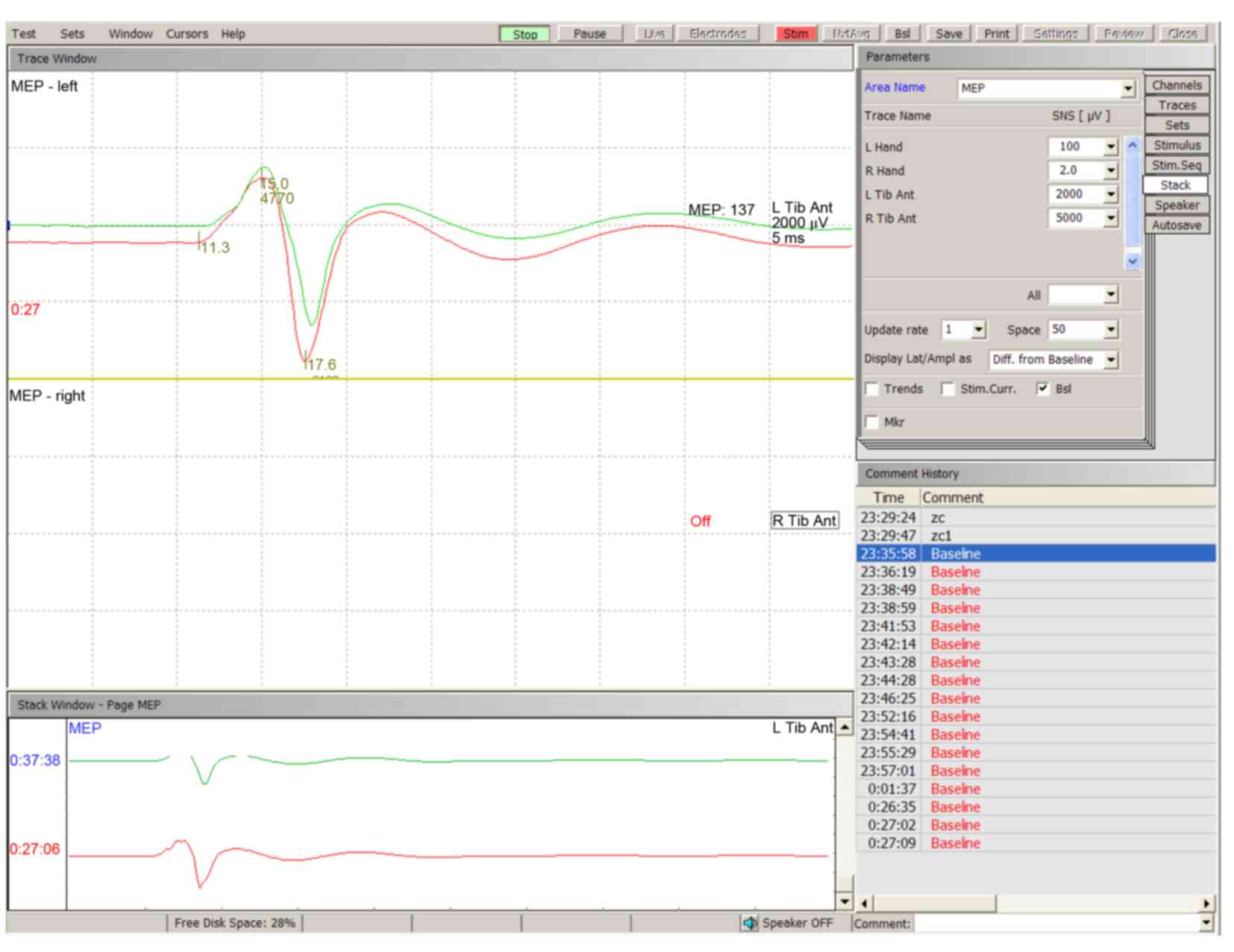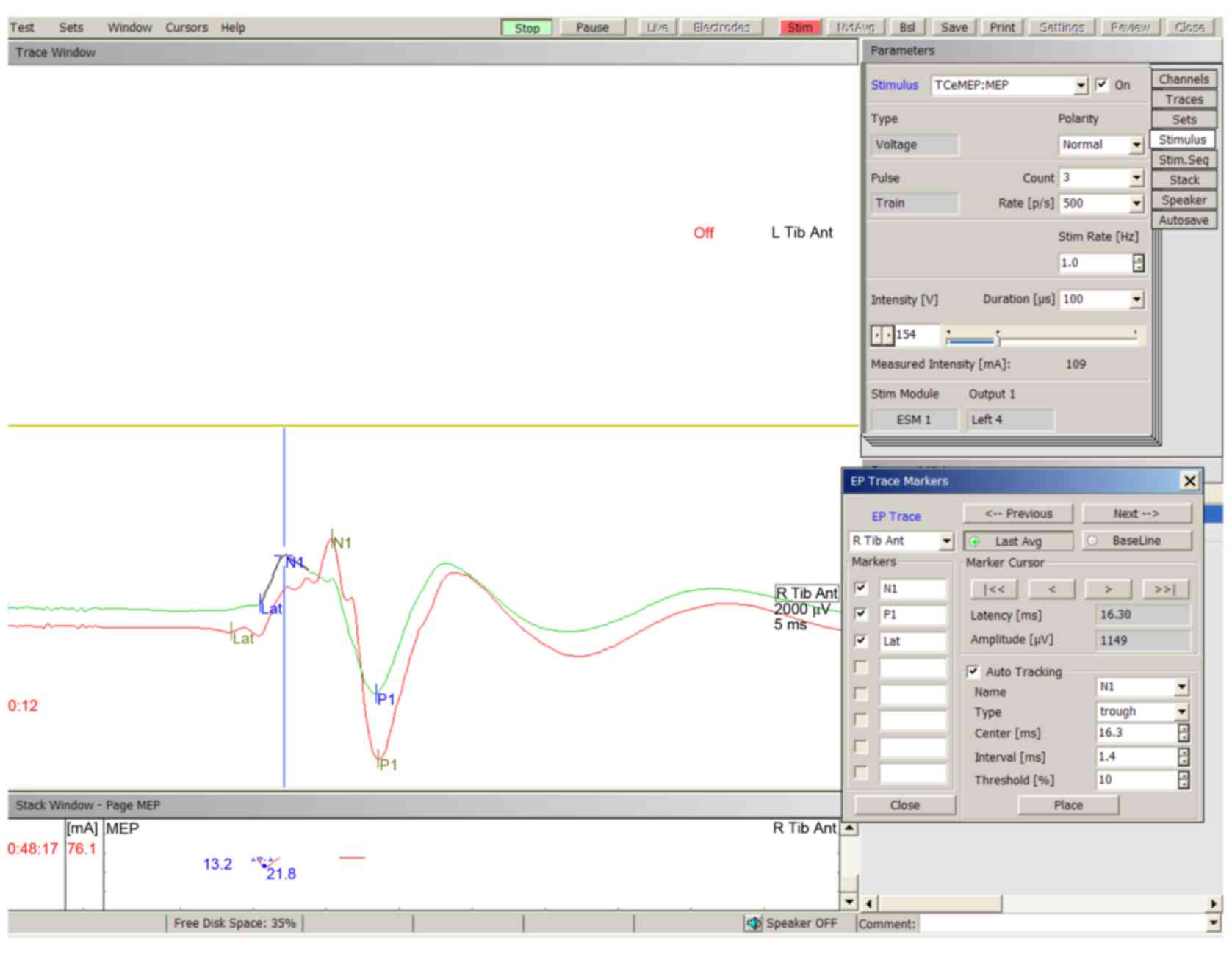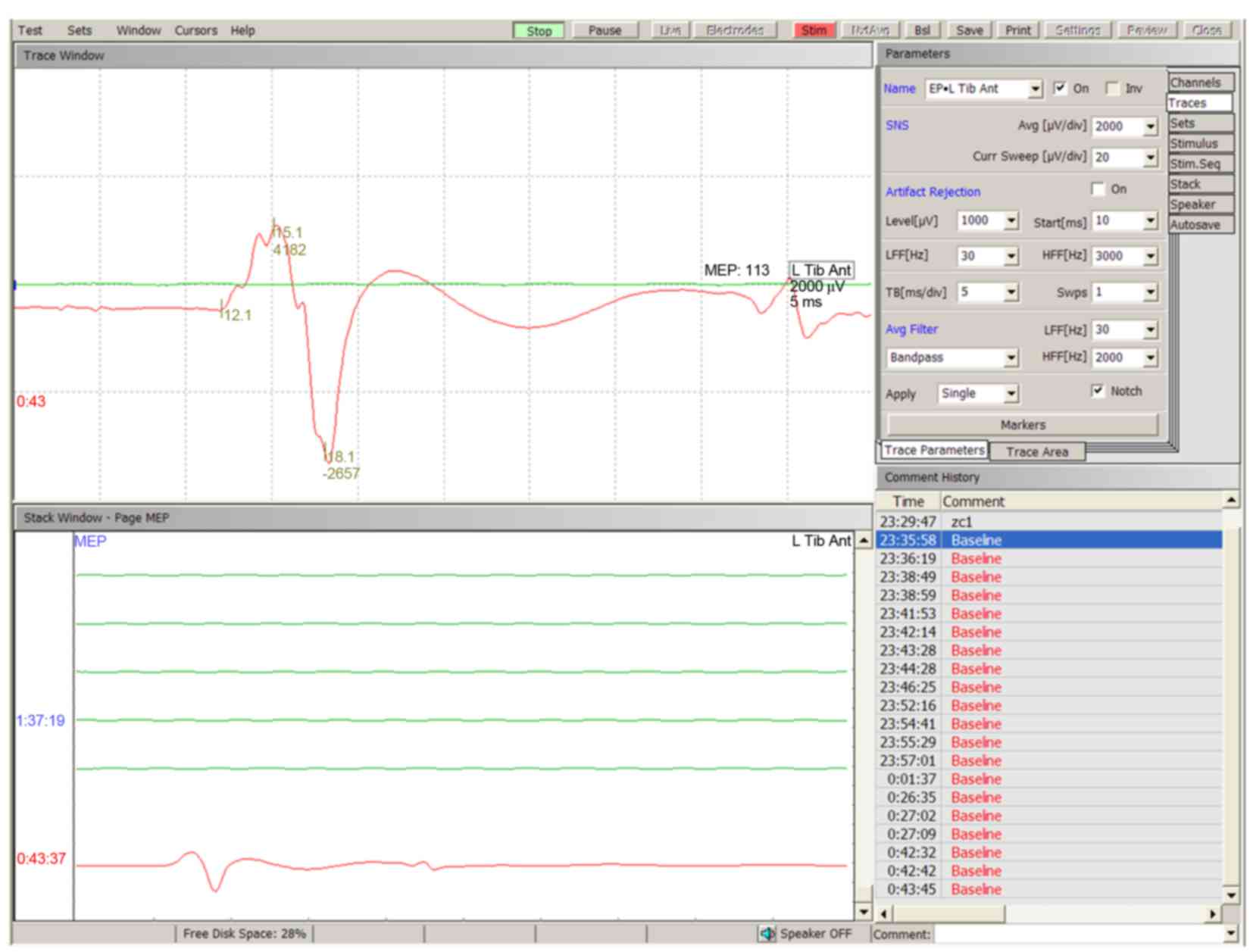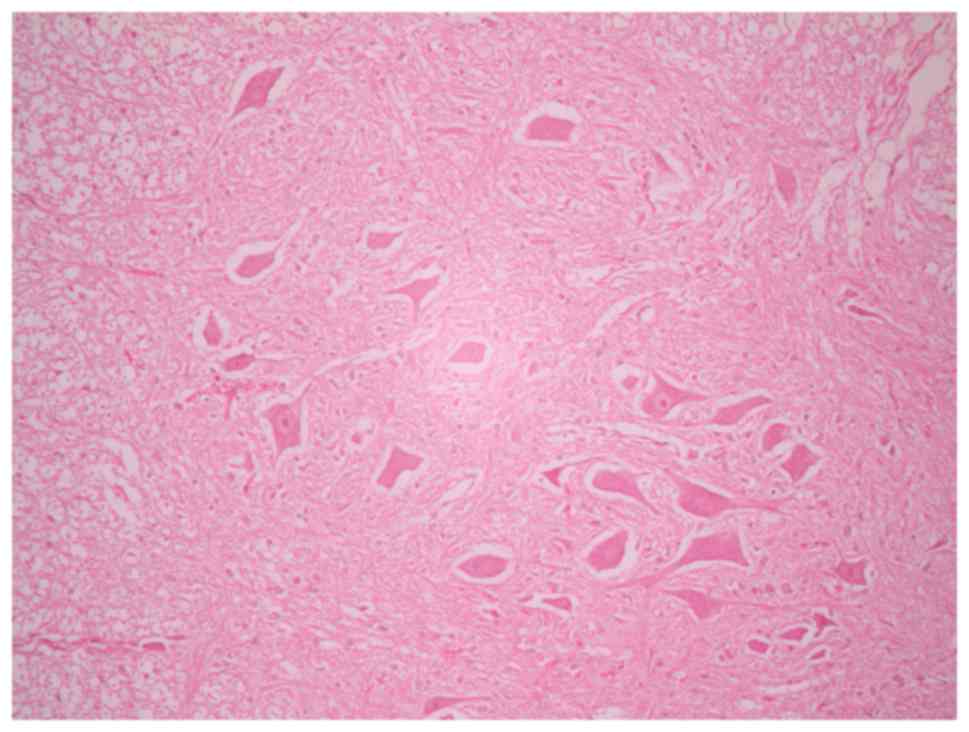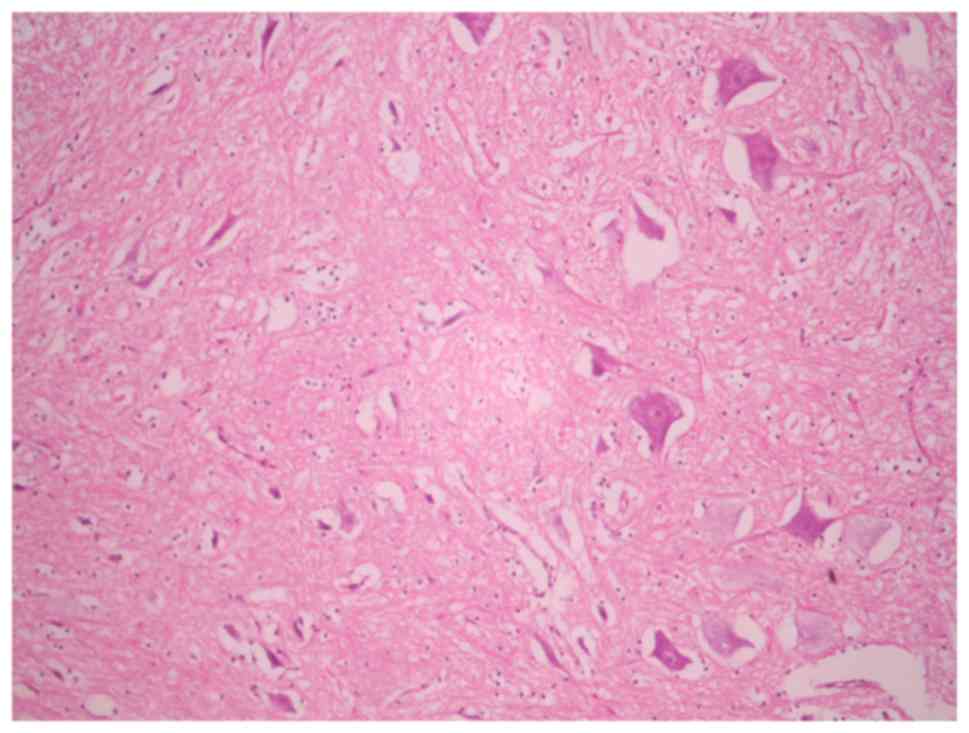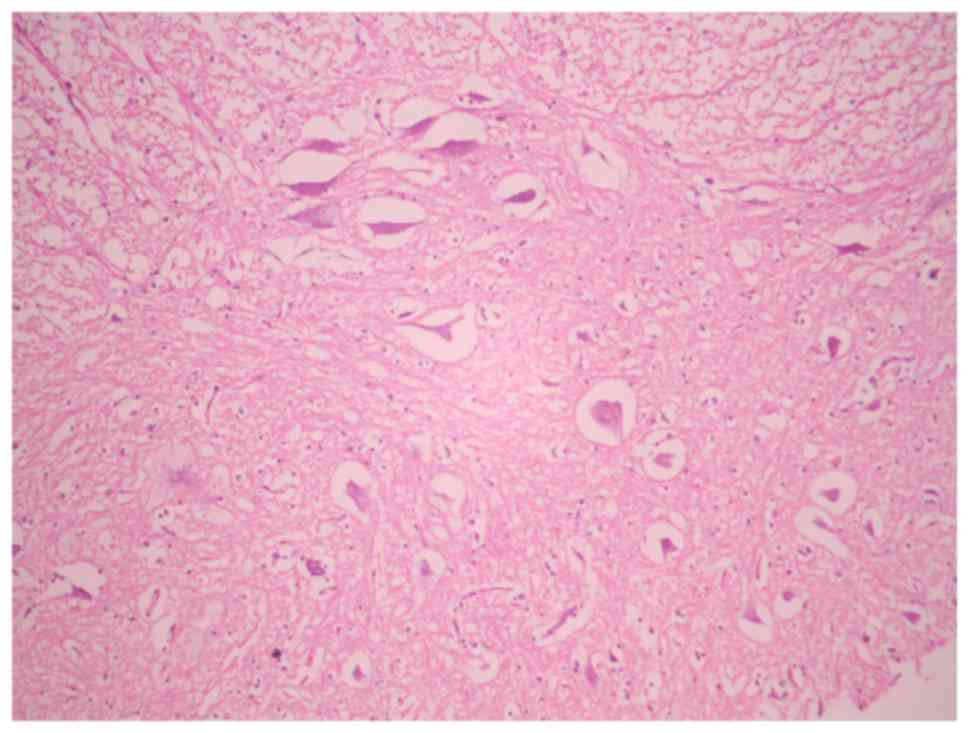|
1
|
Legatt AD, Fried SJ, Amaral TD, Sarwahi V
and Moguilevitch M: Loss of lower limb motor evoked potentials and
spinal cord injury during the initial exposure in scoliosis
surgery. J Clin Neurophysiol. 31:e1–e5. 2014. View Article : Google Scholar : PubMed/NCBI
|
|
2
|
Basoglu H, Kurtoglu T, Cetin NK, Bilgin MD
and Kiylioglu N: Assessment of in vivo spinal cord conduction
velocity in rats in an experimental model of ischemic spinal cord
injury. J Spinal Cord. 51:616–622. 2013. View Article : Google Scholar
|
|
3
|
Mesquita RC, D'Souza A, Bilfinger TV,
Galler RM, Emanuel A, Schenkel SS, Yodh AG and Floyd TF: Optical
monitoring and detection of spinal cord ischemia. PLoS One.
8:e833702013. View Article : Google Scholar : PubMed/NCBI
|
|
4
|
Taskiran E, Brandmeier S, Ozek E, Sari R,
Bolukbasi F and Elmaci I: Multimodal intraoperative
neurophysiologic monitoring in the spinal cord surgery. Turk
Neurosurg. 27:436–440. 2017.PubMed/NCBI
|
|
5
|
Jahangiri FR, Sheryar M and Al Okaili R:
Neurophysiological monitoring of the spinal sensory and motor
pathways during embolization of spinal arteriovenous
malformations-propofol: A safe alternative. Neurodiagn J.
54:125–137. 2014.PubMed/NCBI
|
|
6
|
Ando M, Tamaki T, Yoshida M, Kawakami M,
Kubota S, Nakagawa Y, Iwasaki H, Tsutsui S and Yamada H:
Intraoperative spinal cord monitoring using combined motor and
sensory evoked potentials recorded from the spinal cord during
surgery for intramedullary spinal cord tumor. Clin Neurol
Neurosurg. 133:18–23. 2015. View Article : Google Scholar : PubMed/NCBI
|
|
7
|
Lesser RP, Raudzens P, Lüders H, Nuwer MR,
Goldie WD, Morris HH III, Dinner DS, Klem G, Hahn JF, Shetter AG,
et al: Postoperative neurological deficits may occur despite
unchanged intraoperative somatosensory evoked potentials. Ann
Neurol. 19:22–25. 1986. View Article : Google Scholar : PubMed/NCBI
|
|
8
|
Chang SH, Park YG, Kim DH and Yoon SY:
Monitoring of motor and somatosensory evoked potentials during
spine surgery: Intraoperative changes and postoperative outcomes.
Ann Rehabil Med. 40:470–480. 2016. View Article : Google Scholar : PubMed/NCBI
|
|
9
|
Pillai JB, Pellet Y, Panagopoulos G, Sadek
MA, Abjigitova D, Weiss D and Plestis KA: Somatosensory-evoked
potential-guided intercostal artery reimplantation in
thoracoabdominal aortic aneurysm surgery. Innovations (Phila).
8:302–306. 2013. View Article : Google Scholar : PubMed/NCBI
|
|
10
|
Min HK, Sung K, Yang JH, Kim WS, Jun TG,
Lee YT, Park PW and Park BJ: Can intraoperative motor-evoked
potentials predict all the spinal cord ischemia during moderate
hypothermic beating heart descending thoracic or thoraco-abdominal
aortic surgery? J Card Surg. 25:542–547. 2010. View Article : Google Scholar : PubMed/NCBI
|
|
11
|
Tu XK, Zhang HB, Shi SS, Liang RS, Wang
CH, Chen CM and Yang WZ: 5-LOX inhibitor zileuton reduces
inflammatory reaction and ischemic brain damage through the
activation of PI3K/Akt signaling pathway. Neurochem Res.
41:2779–2787. 2016. View Article : Google Scholar : PubMed/NCBI
|
|
12
|
Shi SS, Yang WZ, Chen Y, Chen JP and Tu
XK: Propofol reduces inflammatory reaction and ischemic brain
damage in cerebral ischemia in rats. Neurochem Res. 39:793–799.
2014. View Article : Google Scholar : PubMed/NCBI
|
|
13
|
Gürer B, Kertmen H, Kasim E, Yilmaz ER,
Kanat BH, Sargon MF, Arikok AT, Ergüder BI and Sekerci Z:
Neuroprotective effects of testosterone on ischemia/reperfusion
injury of the rabbit spinal cord. Injury. 46:240–248. 2015.
View Article : Google Scholar : PubMed/NCBI
|
|
14
|
LeMaire SA, Ochoa LN, Conklin LD, Widman
RA, Clubb FJ Jr, Undar A, Schmittling ZC, Wang XL, Fraser CD Jr and
Coselli JS: Transcutaneous near-infrared spectroscopy for detection
of regional spinal ischemia during intercostal artery ligation:
Preliminary experimental results. J Thorac Cardiovasc Surg.
132:1150–1155. 2006. View Article : Google Scholar : PubMed/NCBI
|
|
15
|
de Haan P, Kalkman CJ, Ubags LH, Jacobs MJ
and Drummond JC: A comparison of the sensitivity of epidural and
myogenic transcranial motor-evoked responses in the detection of
acute spinal cord ischemia in the rabbit. Anesth Analg.
83:1022–1027. 1996. View Article : Google Scholar : PubMed/NCBI
|
|
16
|
Ehrlich M, Knolle E, Ciovica R, Böck P,
Turkof E, Grabenwöger M, Cartes-Zumelzu F, Kocher A, Pockberger H,
Fang WC, et al: Memantine for prevention of spinal cord injury in a
rabbit model. J Thorac Cardiovasc Surg. 117:285–291. 1999.
View Article : Google Scholar : PubMed/NCBI
|
|
17
|
Strauch JT, Lauten A, Spielvogel D, Rinke
S, Zhang N, Weisz D, Bodian CA and Griepp RB: Mild hypothermia
protects the spinal cord from ischemic injury in a chronic porcine
model. Eur J Cardiothorac Surg. 25:708–715. 2004. View Article : Google Scholar : PubMed/NCBI
|
|
18
|
Koçogullari CU, Becit N, Erkut B, Keleş
MS, Ceviz M, Ates A, Gündoğdu C, Kaygin MA and Koçak H: Prevention
of reperfusion injury of the spinal cord in aortic surgery: An
experimental study. Surg Today. 38:237–244. 2008. View Article : Google Scholar : PubMed/NCBI
|
|
19
|
Mazensky D, Radonak J, Danko J, Petrovova
E and Frankovicova M: Anatomical study of blood supply to the
spinal cord in the rabbit. Spinal Cord. 49:525–528. 2011.
View Article : Google Scholar : PubMed/NCBI
|
|
20
|
Noh JH, Cho KR, Yeon JY, Seol HJ and Shin
HJ: Microsurgical treatment and outcome of pediatric supratentorial
cerebral cavernous malformation. J Korean Neurosurg Soc.
56:237–242. 2014. View Article : Google Scholar : PubMed/NCBI
|
|
21
|
Martin DP, Bhalla T, Thung A, Rice J,
Beebe A, Samora W, Klamar J and Tobias JD: A preliminary study of
volatile agents or total intravenous anesthesia for
neurophysiological monitoring during posterior spinal fusion in
adolescents with idiopathic scoliosis. Spine (Phila Pa 1976).
39:e1318–e1324. 2014. View Article : Google Scholar : PubMed/NCBI
|
|
22
|
James WS, Rughani AI and Dumont TM: A
socioeconomic analysis of intraoperative neurophysiological
monitoring during spine surgery: National use, regional variation,
and patient outcomes. Neurosurg Focus. 37:E102014. View Article : Google Scholar : PubMed/NCBI
|
|
23
|
Stöckl B, Wimmer C, Innerhofer P, Kofler M
and Behensky H: Delayed anterior spinal artery syndrome following
posterior scoliosis correction. Eur Spine J. 14:906–909. 2005.
View Article : Google Scholar : PubMed/NCBI
|
|
24
|
Ji Y, Meng B, Yuan C, Yang H and Zou J:
Monitoring somatosensory evoked potentials in spinal cord
ischemia-reperfusion injury. Neural Regen Res. 8:3087–3094.
2013.PubMed/NCBI
|
|
25
|
Mônaco BA, Benício A, Contreras IS,
Mingrone LE, Ballester G and Moreira LF: Ischemic preconditioning
and spinal cord function monitoring in the descending thoracic
aorta approach. Arq Bras Cardiol. 88:291–296. 2007.(In English,
Portuguese). View Article : Google Scholar : PubMed/NCBI
|
|
26
|
Gunnarsson T, Krassioukov AV, Sarjeant R
and Fehlings MG: Real-time continuous intraoperative
electromyographic and somatosensory evoked potential recordings in
spinal surgery: Correlation of clinical and electrophysiologic
findings in a prospective, consecutive series of 213 cases. Spine
(Phila Pa 1976). 29:677–684. 2004. View Article : Google Scholar : PubMed/NCBI
|
|
27
|
Wiedemayer H, Sandalcioglu IE, Armbruster
W, Regel J, Schaefer H and Stolke D: False negative findings in
intraoperative SEP monitoring: Analysis of 658 consecutive
neurosurgical cases and review of published reports. J Neurol
Neurosurg Psychiatry. 75:280–286. 2004.PubMed/NCBI
|
|
28
|
Stecker MM: A review of intraoperative
monitoring for spinal surgery. Surg Neurol Int. 3 Suppl
3:S174–S187. 2012. View Article : Google Scholar : PubMed/NCBI
|
|
29
|
Clark AJ, Ziewacz JE, Safaee M, Lau D,
Lyon R, Chou D, Weinstein PR, Ames CP, Clark JP III and Mummaneni
PV: Intraoperative neuromonitoring with MEPs and prediction of
postoperative neurological deficits in patients undergoing surgery
for cervical and cervicothoracic myelopathy. Neurosurg Focus.
35:E72013. View Article : Google Scholar : PubMed/NCBI
|
|
30
|
Szelényi A, Heukamp C, Seifert V and
Marquardt G: S100B, intraoperative neuromonitoring findings and
their relation to clinical outcome in surgically treated intradural
spinal lesions. Acta Neurochir (Wien). 156:733–739. 2014.
View Article : Google Scholar : PubMed/NCBI
|
|
31
|
Simó M, Szirmai I and Arányi Z: Superior
sensitivity of motor over somatosensory evoked potentials in the
diagnosis of cervical spondylotic myelopathy. Eur J Neurol.
11:621–626. 2004. View Article : Google Scholar : PubMed/NCBI
|
|
32
|
Kobayashi S, Matsuyama Y, Shinomiya K,
Kawabata S, Ando M, Kanchiku T, Saito T, Takahashi M, Ito Z,
Muramoto A, et al: A new alarm point of transcranial electrical
stimulation motor evoked potentials for intraoperative spinal cord
monitoring: A prospective multicenter study from the spinal cord
monitoring working group of the Japanese Society for spine surgery
and related research. J Neurosurg Spine. 20:102–107. 2014.
View Article : Google Scholar : PubMed/NCBI
|
|
33
|
Zivin JA and DeGirolami U: Spinal cord
infarction: A highly reproducible stroke model. Stroke. 11:200–202.
1980. View Article : Google Scholar : PubMed/NCBI
|
|
34
|
de Haan P, Meylaerts SA, Lips J and Jacobs
MJ: Development of spinal cord ischemia after clamping of
noncritical segmental arteries in the pig. Ann Thorac Surg.
68:1278–1284. 1999. View Article : Google Scholar : PubMed/NCBI
|
|
35
|
Legatt AD: Current practice of motor
evoked potential monitoring: Results of a survey. J Clin
Neurophysiol. 19:454–460. 2002. View Article : Google Scholar : PubMed/NCBI
|
|
36
|
Liu LY, Callahan B, Peterss S, Dumfarth J,
Tranquilli M, Ziganshin BA and Elefteriades JA: Neuromonitoring
using motor and somatosensory evoked potentials in aortic surgery.
J Card Surg. 31:383–389. 2016. View Article : Google Scholar : PubMed/NCBI
|
|
37
|
Reuter DG, Tacker WA Jr, Badylak SF,
Voorhees WD III and Konrad PE: Correlation of motor evoked
potential response to ischemic spinal cord damage. J Thorac
Cardiovasc Surg. 104:262–272. 1992.PubMed/NCBI
|
|
38
|
Kakinohana M, Abe M, Miyata Y, Oshiro M,
Saikawa S, Arakaki K, Kuniyoshi Y and Sugahara K: Delayed response
of transcranial myogenic motor-evoked potential monitoring to
spinal cord ischemia during repair surgery for descending thoracic
aortic aneurysm. J Anesth. 22:304–307. 2008. View Article : Google Scholar : PubMed/NCBI
|
|
39
|
Nemoto M: Animal experiment on spinal cord
ischemia with evoked potentials by transcranial electrical
stimulation. J Juntendo Igaku. 43:586–598. 1998. View Article : Google Scholar
|
|
40
|
Kim DG, Son YR, Park YS, Hyun SJ, Kim KJ,
Jahng TA, Kim HJ and Park KS: Differences in multimodality
intraoperative neurophysiological monitoring changes between spinal
intramedullary ependymoma and hemangioblastoma. J Clin
Neurophysiol. 33:120–126. 2016. View Article : Google Scholar : PubMed/NCBI
|
|
41
|
Kothbauer KF: Intraoperative
neurophysiologic monitoring for intramedullary spinal-cord tumor
surgery. Neurophysiolo Clin. 37:407–414. 2007. View Article : Google Scholar
|



